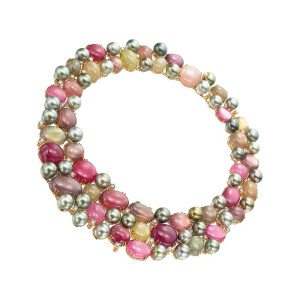Saltwater cultured pearls
There are basically three different types of saltwater cultured pearls: Akoya, Tahitian, and South Sea.
- Beginning in the 1900s, Akoya pearls were the first variety to be cultivated in Japan. Usually created using Pinctada fucata oysters, most Akoya cultured pearls are white or cream, with some exhibiting hints of pink or green. The Akoya oyster is relatively small, so it does not usually produce a cultured pearl larger than 9 mm. Akoyas are considered a step above freshwater pearls in quality.
- Tahitian pearls have only been on the market since the 1970s. The black-lipped oyster—Pinctada margaritifera—produces Tahitian pearls in colours like eggplant purple, peacock green, and a wide variety of greys, including nearly black and greyish blue. The black-lipped oyster is native to French Polynesia and is also farmed in the nearby Cook Islands. It can grow as large as 30 cm (12 in.) in diameter, sometimes weighing 5 kg (11 lbs), and produce pearls from 9 mm to 20 mm.
- South Sea pearls are grown in the warm waters of Australia, the Philippines, Indonesia, Myanmar (formerly known as Burma), and Thailand. These areas are the natural habitat of the huge oyster, Pinctada maxima, which occurs in two varieties: the silver lip and gold lip. They can be identified by the colour of the shell’s external lip.

South Sea pearls are the largest pearls in the market and have the thickest nacre of all varieties, making them more resilient to wear. Although they keep their lustre for years on end, they are also more difficult and more costly to produce. This is due to their longer gestation period—usually two years—and the constant monitoring of water quality required to grow them. This combination of factors makes South Sea pearls the rarest and most precious of all.
In general, silver-lip Pinctada Maxima creates pearls that are white, silver, and slightly pinkish in colour, while the gold-lip kind produces pearls in a variety of yellow and golden hues. Both silver lip and gold lip produce pearls in the 9- to 20-mm range, with 13 mm being the average size.
The size of a pearl is determined by the oyster’s ability to secrete nacre. Generally speaking, Pinctada Maxima produces the best quality of nacre. Thick nacre creates a suffused opalescence, tinted by a kind of metallic brilliance that determines the pearl’s colour. With its wide range of colours, South Sea pearls have become a favourite among jewellery designers. In fact, mixing various colours can create a hipper look that appeals to younger fashionistas. The incredible variety of South Sea pearls is also a great source of inspiration for jewellery designers.
Now that you have a better sense of what to look for when buying pearls, it’s time to push your own boundaries. A dainty strand of pearls is timeless, but today’s designers are broadening the appeal of these gems with edgy and fashion-forward styles perfect for the classy and chic customer. With these, you just may find yourself moving your pearl selection off the back wall.
Massimo Marocco is a pearl buyer and grader, and has served as stone manager of Utopia-Gaia for the last 27 years. He is a graduate of Gemological Institute of America’s (GIA’s) pearl and pearl grading course. He can be reached at massimo.marocco@gaia.it. Manuel Martin is director of U.S. operations for Utopia-Gaia. He can be reached at m.martin@utopia-jewels.com.





